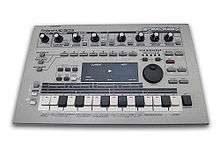Roland MC-303
The Roland MC-303 is the first of a series of musical instruments known as a Groovebox. It combines a simple sound module with a sequencer to record and store notation, along with controls aimed at encouraging the musician to improvise the music while it is playing. Despite the number in its name and the attention it received at its launch, the MC-303 has more in common with other MC prefixed synthesizers (such as the Roland MC-202), which contain built-in sequencers, than it does with the famous Roland TB-303. As the first Groovebox, the MC-303 was the first in a line of inexpensive products specifically targeted towards house DJs and amateur home musicians rather than professional producers. It was superseded by the Roland MC-505. It is the predecessor to the Roland D2, Roland MC-307, Roland MC-909 and the Roland MC-808.
| Roland MC-303 groovebox | |
|---|---|
 | |
| Manufacturer | Roland |
| Dates | 1996–1997 |
| Price | £565 UK, $699 US |
| Technical specifications | |
| Polyphony | 24-note |
| Timbrality | 8-part |
| Synthesis type | Sample-based synthesis (rompler) |
| Storage memory | 448 preset sounds, 12 drum kits |
| Effects | reverb/delay, chorus/flanger |
| Input/output | |
| Keyboard | No |
| External control | MIDI in/out |
Features
The key features of the MC-303 are:
- Sound generator with 24 note - voice polyphony based on the structure model of Roland JV-80 synthesizer
- 8-track sequencer (7 pitched instruments and 1 drum kit)
- 8 part timbrality
- 448 preset sounds and 12 drum kits (includes the Roland CR-78, TR-808, TR-606 & TR-909)
- Reverb/delay and chorus/flanger effects
- 300 onboard dance music variation patterns such as drumbeats and basslines
- Recording length of up to 32 bars per pattern
- Instant storage of up to 50 user patterns, 300 pattern variations and 10 songs
- Storage space for up to approximately 14,000 notes
- MIDI in and out connections (but no MIDI thru)
Synthesizer/Sound Module
The synthesizer built into the Roland MC-303 is a rompler which contains sounds largely drawn from classic Roland synths and drum machines such as the TB-303, TR-808 and TR-909 along with the Juno series and various other dance themed sounds such as pads, pianos, strings and vinyl scratches. The sounds can be manipulated with a low-pass filter, various modulation capabilities and some simple DSP effects. It doesn't have a sampler, although the instruction book contains instructions for getting it to control an external sampler.
Sequencer
The most important part of the MC-303 is its built-in pattern based 8 track sequencer. Each pattern can contain up to 32 bars. It can record and send MIDI data via the MIDI jacks on the rear panel, enabling its internal sequencer to control other sound modules, or its internal sound module to be controlled by an external sequencer. Although communication with other devices is possible, the main advantage to the MC-303 with its small form factor and all-in-one design is the ability to use it as a self-contained studio, albeit an amateur one. Featuring a micro-keyboard that can also be used as a drum sequencer, the MC-303 imitates the handling as well as the look and feel of other famous Roland synthesizers and drum machines such as the MC-202, TB-303, TR-808 and TR-909.
Supply problems
Roland apparently underestimated the demand for the new module with the result that many did not receive the modules until months after its launch.
Criticisms
One criticism made of the machine in various reviews, including the August 1996 issue of Sound on Sound magazine,[1] was that the sound module was essentially limited to only playing built-in preset sounds, discouraging innovation. From a more technical perspective, a major concern was that any knob tweaks made during real time recording were not transmitted via MIDI. The number of preset patterns (mostly aimed for Trance and Techno music) outweighed the amount of programmable user patterns which also discouraged innovation. Roland responded in part to these criticisms in its later grooveboxes by solving the MIDI problem, increasing the synthesis capabilities & user pattern storage and adding a sampler section.
Software ROM Chip Update (not in Roland information)
Check your MC-303 ROM Chip Update: 'SHIFT'+'SCALE'+'R (BD)' Circulated ROM BIOS Versions: V1.00(1996); V1.01; V1.02 and V1.03(1997)*
- [Latest ROM Chip is more stable.]*
References
- Derek Johnson; Debbie Poyser (August 1996). "Hip Replacement". SOS Publications Group. Retrieved 2009-01-31.
Further reading
- "Roland MC-303". Future Music. No. 43. Future Publishing. May 1996. p. 24. ISSN 0967-0378. OCLC 1032779031.
External links
MC-303 PDF Manual Links:
Other Links:
- Roland UK Limited, MC-303 site and files
- Roland US Corporation, MC-303 site and files
- FutureProducers.com - 'musicians learning from musicians' - Roland MC-303 Forum.
- Harmony Central - 'Leading Internet resource for musicians, supplying valuable information from news and product reviews' - Roland MC-303
- PLANET 303 Web Page